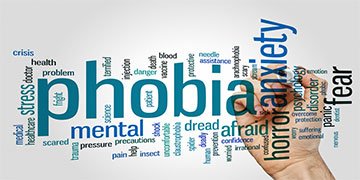Treat your phobia and fear in Cardiff using hypnotherapy
Richard2023-06-03T22:32:56+01:00Treat your phobia and fear in Cardiff using hypnotherapy
Are you ready to treat your phobia and fear in Cardiff using hypnotherapy?

Avoidance of a fearful situation is a natural, short-term response to feel safe. In the long-term however, the avoidance behaviour can leave you helpless and stuck with a situation that is far more challenging to overcome. When you are ready to confront your phobia, you have decided at some level that avoidance is no longer the best option for you.
Your decision to overcome your phobia or fear may have been prompted from an external situation or forthcoming lifestyle change. I often ask my clients their reasons for confronting their phobia and fear. They include health changes, internal conflicts, despair, embarrassment, relationship issues, travel arrangements, study needs, conflicts within your family, fear that your children will learn your phobic response, general lifestyle changes, promotion at work or potential situations in your next job.
Whatever your motive to change, you can live your life freely with your anxiety in the distant past when you want to treat your phobia and fear in Cardiff using hypnotherapy.
How will your phobia be treated?
A previous BMJ publication by Vickers and Zollman gave a clinical review of existing research on hypnosis and relaxation therapies. It concluded that there is good evidence from randomised controlled trials that hypnosis is an effective treatment for phobias and fears.
My treatment therapy will essentially use a variety of hypnotic techniques to help you overcome your phobia and fear. Some types of phobias need a different treatment approach e.g. when treating a fear of fainting compared to a fear of spiders. In addition to this, each client also brings different core beliefs and issues into the treatment process. These need to be analysed to find the most appropriate hypnotic solution.
Hypnotherapy treatment techniques can involve strategies such as removing the emotional “cause” of your phobia or fear, anxiety control, and changing the thoughts, emotions and behaviour connected to your phobia. The treatment will also apply methods used in CBT and controlled exposure to ensure that you are benefitting from other effective processes used to alleviate phobias and fears.
Can you treat your phobia and fear in Cardiff using hypnotherapy if you have an uncommon phobia or fear?
Some of the more common phobias and fears include:
- Agoraphobia – commonly considered as a fear of open spaces, but is characterised by the fear of leaving home. When you are outside, you fear having a panic attack in a confined space or around other people where you would feel extreme embarrassment. The need to rush home to your “safe” place exacerbates the agoraphobia.
- Arachnophobia – a fear of spiders.
- Phonophobia – a fear of loud noises from any source e.g. balloons, fireworks, car engines, thunder etc.
- Phagophobia – a fear of swallowing usually when eating food but can also be experienced with liquids or saliva.
- Emetophobia – a fear of being sick, your own or somebody else’s vomit.
- Pseudodysphagia – a fear of choking, sometimes related to phagophobia.
- Vaginismus – a fear of pain with vaginal penetration or intercourse.
- Aerophobia – a fear of flying.
- Toilet phobia – also known as parcopresis. This fear of defecation in a public place can also be related to irritable bowel syndrome.
- Urination phobia – also known as paruresis, shy bladder syndrome, bashful bladder and pee shyness.
- Katagelophobia or social phobia – fear of embarrassment, attention, judgement, and humiliation.
- Claustrophobia – a fear of confined spaces.
- Acrophobia – a fear of heights.
- Mysophobia – a fear of germs or contamination commonly associated with obsessive compulsive disorder.
- Pyrophobia – a fear of fire.
- Xenophobia – a fear of strangers.
- Entomophobia – a fear of insects.
- Speksophobia – a fear of wasps.
- Cibophobia – a fear of food. Food is avoided to minimise illness (contamination) or vomiting (emetophobia). It can also be called a restrictive eating behaviour when there is a disgust/panic/choking response with certain food types. It can also be mistaken for anorexia.
- Gamophobia – fear of commitment, affecting long-term relationships but can affect other lifestyle situations such as long contract work, mortgaging a house and staying in one city location.
- Hydrophobia & Aquaphobia – a fear of water and drowning.
- Ophidiophobia – a fear of snakes.
- Panic disorder – a fear of panic attacks which can be associated with hypochodriasis, medical anxiety and health anxiety.
- Hemophobia (blood phobia), trypanophobia (injections phobia) and traumatophobia (injury phobia) which can develop a fear of fainting or passing out.
- Illyngophobia – a fear of vertigo (or feeling dizzy).
- Belonephobia – a fear of needles.
- Atychiphobia or Kakorrhaphiophobia – fear of losing control.
- Nosophobia – fear of illness, health anxiety or hypochondriasis.

If your phobia or fear is obscure and is not listed as a common phobia, you can still treat your phobia and fear in Cardiff using hypnotherapy. Your phobia and fear will have a sensitising event and subsequent reactions in which you have associated your panic attack. The acute anxiety or panic attack is common with all other phobias and fears. The treatment will analyse your individual background experiences and disconnect your panic response using some of the same hypnotherapy techniques discussed in this article.
Are phobia sufferers receptive to hypnosis?
There are many intra-personal and inter-personal factors that can influence how receptive you are to hypnosis, including a strong desire and commitment to change your behaviour. When you have made the decision to seek professional help from a hypnotherapist, you are already a step closer to being open to therapeutic hypnotic suggestions. What then happens during your treatment will continue that process to its resolution.
When I look back at the profiles of my previous phobia clients, almost all of them have been highly responsive to hypnosis. Does this reliably mean that phobia sufferers can be hypnotised easily? Studies from Stanford University state that phobia sufferers “tend to score high on hypnotic susceptibility scales and… respond favourably to hypnotic intervention.”
Are phobia sufferers generally treatable? In the same article, a psychologist Joseph Barber, PhD considers that the source of a problem and its resolution can conveniently originate from the same place. “The very capacity that lends itself to developing the problem is the same that lends itself to solving it.” Barber considers the learning of phobias as “environmentally suggested anxiety”; which means that the anxiety can be effectively un-learned or relearned with the use of external therapeutic suggestions. You can assess your level of suggestibility using this hypnosis test.
What happens in your first phobia and fear hypnotherapy consultation?
The first important stage in your phobia and fear treatment is to analyse your individual phobic or fearful situation. This is conducted in the early stage of the first consultation but can also continue through your treatment as new issues are uncovered. Every situation can be different and this process ensures that your treatment is individualised to your specific needs. The process includes the following:
Establish the history of your direct and indirect traumas: This usually answers the “how and why” you have arrived at your phobic or fearful situation. Sometimes this is obvious with direct traumas, but with complex situations like agoraphobia, it may involve a number of issues. By understanding this pathway, it helps you to appreciate how your sensitising events have affected you and continues to inhibit the achievement of your goal (the removal of your phobia).
Identify any conflicting beliefs and emotions: Other beliefs and emotions (outside of your specific phobic or fear) may have contributed to your phobic situation. For example, during your teenage years, defiance may have added anger into your coping strategies when people tried to control how you should deal with your insect phobia. So anger and anxiety are now triggered when you confront insects because you anticipate people interfering with how you will cope with your phobic situation. Or social anxiety during your teenage years may have added embarrassment into trying to confront your wasp phobia. So now when you have to cope with the fear from wasps, you also feel embarrassment from your anticipated peer’s judgements.
Examine your coping strategies: In most cases, the (negative) coping strategies that you have previously employed have gradually transformed your fear of a situation into the current phobic situation with panic attacks. With repetition sustained over a long time period, your reactions have now made your coping strategies automated even though you try your best to keep yourself safe from perceived danger. This build up of avoidance reactions can create a complex phobic situation especially when it involves more than one fear. Aviophobia (fear of flying) can involve direct flight-related traumas, but it can also be a complex situation that involves a number of fears e.g. a fear of heights, fear of confined spaces and social anxiety. In order for you to maximise the effective use of your new therapeutic coping strategies and prevent “flooding” of anxiety, this process is made easier when a complex phobic situation has been analysed.
Define your treatment pathway: In response to the analysis of these specific and wider issues that impact on your phobia and fear, your treatment plan can then be formulated to ensure that it is individualised and goal-oriented.
How can hypnotherapy treat your phobia and fear?
Listed below are some of the ways that you can benefit when you are ready to treat your phobia and fear in Cardiff using hypnotherapy:

- Treat your phobia and fear in a controlled environment
Hypnotherapy offers you the opportunity to confront your fears in a controlled and detached environment, limiting the amount of exposure to your situation so that you are not overwhelmed (flooded) with panic. Hypnotherapy also allows you to safely deal with your fears and the removal of your panic response at an unconscious level. You can accept positive suggestions without interference of your conscious mind.
- Control of your anxiety and panic response
You may not feel that you have conscious control over your phobic response but appreciate that you have ownership of your reaction; it’s yours to change. Your hypnotherapy treatment will help you to alleviate your panic symptoms that cause you to feel so traumatised when confronting your phobia and fears. For example breathlessness (hyperventilation) is a common symptom of panic. After learning relaxed breathing techniques, these techniques will be incorporated into your hypnosis treatment so that your breathing rate and breathing style can be calmer when you are ready to deal with your phobic situation. Other symptoms like palpitations, shaking, profuse sweating etc. will also be alleviated in your hypnotherapy treatment.
- Treat anticipatory anxiety
With some anxious situations, the build up to the situation can be as bad (if not worse) than the actual demands needed to cope with the situation. Your anxious mind will instinctively play any number of random “what if…” scenarios where you meet your doom. Learning to cope with anticipatory anxiety is integrated into your phobia treatment so that you can disconnect the anxious build up to the phobic situation. You can then apply your positive resources when it is needed during the phobic situation.
Fear and panic dominate most phobias, but your panic response may combine with (or be specific to) a disgust reaction. When your disgust response is triggered, it creates such an overwhelming, internal feeling of revulsion that you are then unable to cope with this emotional response and you fear it being activated by your phobic object or situation. Disgust reactions are common with certain phobias such as a fear of vomiting, fear of insects, fear of holes, fear of germs, fear of blood, etc. They can also contribute to a penetration phobia (vaginismus) depending on your individual background history. Dissociating your emotional disgust reaction is essential for you to overcome this type of phobia.
- Treat your fear of fainting with a blood phobia, injection phobia or injury phobia
About 15% of the population have an in-built fainting response (some people sense it before fainting, whilst with others it happens spontaneously). Physiologically, fainting occurs when blood pressure spikes due to the initial anxiety and then suddenly drops, causing blood to be diverted away from the brain. There numerous physiological explanations (e.g. vasovagal response) and self protective psychological theories why a fainting response is activated. Fear and disgust are the emotions responsible for the creation of a blood, injection or injury phobia. If you have previously fainted or near fainted, it can then trigger this additional fear with the insecurity and embarrassment that can accompany it. Your hypnotherapy treatment is specific to keeping your blood pressure raised as you confront your fears and inhibit your fainting response. This particular hypnotherapy treatment technique is a method also used in The Applied Tension Technique.
- Assisted desensitisation (controlled exposure)
When you research how to treat phobias, you will see the term desensitisation or controlled exposure appear time and time again. Desensitisation is an effective way of treating phobias. By itself however, this method can be cumbersome and time consuming. Hypnosis can offer you the positive mental rehearsals that act as accelerated controlled graduated exposure away from the phobic situation. So when you are ready to progressively deal with your fearful situation, you will feel as if you have already done the practise with the appropriate positive mindset. When combining hypnosis with desensitisation, you can expect a rapid progression your phobia and fear solution.
- Treat the causes of your phobia and fear (sensitising event)
This technique is favoured less by solution focused hypnotherapists who tend to disregard the influence of the past on the treatment of a phobia. The sensitising event holds the repressed emotions contained in the memories that “cause” the phobia and generates the anticipatory anxiety (panic attack) when confronting similar future incidents. When the emotions contained in the sensitising event are released (as an abreaction), it can have a dramatic effect on the alleviation of your phobia. This technique uses regression to identify the experiences just before the sensitising event so that the unconscious details of the trauma (e.g. beliefs held at that time and conflicts that influenced the learning of the anxious response) can be studied and reframed. When you remove the roots, you set free everything above the ground to allow new positive resources to be planted. The Rewind Technique can sometimes be used with some clients with the same purpose of reframing the traumatic emotions contained within the sensitising event or panic attack.
- Visualisation of your desired positive experience

Visualisation is a powerful tool in phobia and fear treatment
Visualisation is a powerful tool that can launch you towards the achievement of your goal. When you visualise positive change, you are creating the network of neural pathways that can be accessed more easily when you are in that situation. Hypnosis is a relaxed state where the depth of visualisation is enhanced. When you visualise in hypnosis, it’s as if you are passing those “real” imagined experiences down into your unconscious mind to help it accept that this is the new reality without actually being in the experience. Put another way, you are accessing the necessary “in-vivo” controlled exposure that can sometimes be difficult to access in real life situations. For example, when you have a wasp phobia and you want to practise your relaxation techniques with a wasp nearby without being re-traumatised with panic. It can be difficult to recreate a controlled situation involving real wasps. In hypnosis, you can do the “mind work” necessary to dissociate your panic reaction without always having to access the real life situation.
But hypnotherapy can you offer more than just visualisation when using advanced techniques. Many of the cognitive restructuring processes used in CBT can be applied during hypnosis, helping you to accelerate the change of your thought patterns towards the removal of your phobia or fear.
Contact me for more information
So when you are ready to treat your phobia and fear in Cardiff using hypnotherapy, please contact me giving a few brief details of your phobia. These details will help me understand the precise nature of your phobia or fear however obscure you think it may be. This information will be treated in the strictest confidence.












